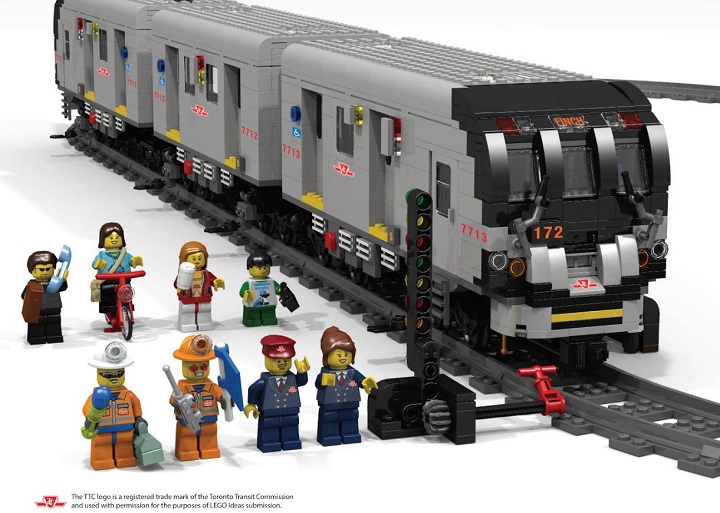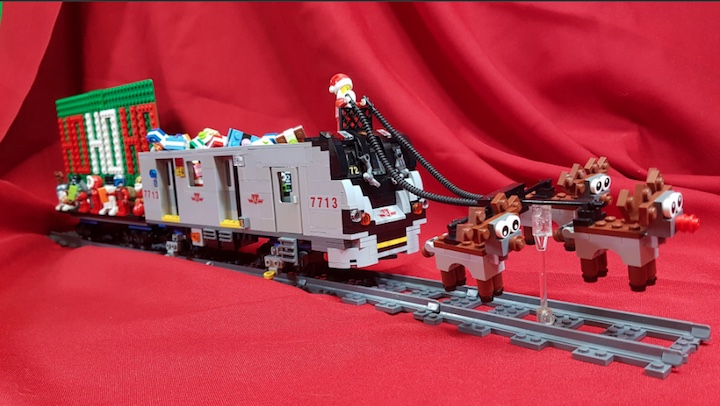As Toronto Transit Commission subway operator Aaron Chapman prepares to showcase his prized creation at the transit agency’s busiest station for an upcoming Christmas display, it’s an item that could find itself on wish lists in the years ahead.

The Toronto Rocket kit, a 2,910-LEGO block, three-cab subway train, was developed by Chapman and submitted to LEGO Ideas, an open process for potential new products by the famous plastic construction toy company. People can vote for their favourite creations, and if there’s enough support, the design could be picked up for development by LEGO.
Chapman, a former longtime graphic designer who has only been a TTC subway operator for less than two years, said he began his project in February. A self-described “LEGO nerd,” he said he collects LEGOs as a personal hobby and received a train set from his wife.
“It’s nothing like the trains we drive, and it didn’t have any details, so I decided to make my own,” Chapman told Global News.
“My co-workers where I work (at the Wilson subway yard) saw it, as they did the progression of me making it, and said: ‘I want one, I want one.'”
He said that with the TTC’s support, he put forward his idea and launched a campaign for public support. Chapman said LEGO will review the idea once the project receives 10,000 votes. He has until March 2020 to get the required support.
But in order for the project to be considered, it needs to demonstrate momentum and meet certain milestones based on the number of supporters it gets in order to be granted time extensions.
- S&P/TSX composite closes up nearly 100 points, U.S. stock markets mixed
- Pedestrian in life-threatening condition after being hit by vehicle in Mississauga
- Judge at trial of man accused of killing cop was concerned over Crown changing theory
- Ontario transportation minister pitches 24-hour work to speed up Gardiner construction
Ultimately, if the concept is approved, the kit could be produced in a limited run or shared worldwide.
When asked about the type of feedback he has received, Chapman said people are generally “flabbergasted” after seeing the train.
“They love the idea of it. It’s a Canadian-made train … I’m Canadian-born, it’s operating exclusively in Canada and it’s a Canada everything,” Chapman said, adding that he has taken his prototype to TTC events and train shows.
“It is shocking at how much people have a nostalgic thing for a train. For me, it wasn’t anything spectacular until I became an operator.”
When it comes to getting commercial and institutional backing, he admitted there were skeptics at first. Chapman said he has contacted companies offering to put advertising on the side of the train, something that currently happens with real TTC trains.
He added that when he contacted his union to pitch the concept and get the membership involved, he “almost got laughed out of the room” when he initially showed up.
“When I pulled it out (of a protected carrying case), their jaws hit the floor. When people see it, it’s like a whole different thing,” Chapman said.
However, building a functioning prototype hasn’t been easy.
READ MORE: LEGO wheelchair gives stray kitten new lease on life
“When people see the train and as realistic as I have been able to make it — it’s taken me about 250 hours of modelling and building to get it to be authentic — they’re amazed at how I was able to make everything work,” he said.
Chapman said the first version of the train he tried to build, based on a digital design of pieces, fell apart. He said it took several hours to refine the train based on LEGO pieces he owned to make it structurally sound. The latest version of the train kit includes finer details, such as controls in the driver cab and special-order doors.
“The real challenge was finding pieces that fit and then finding a way to get those pieces to go together,” Chapman said, noting that the curves and the continuous connection of the newer Toronto Rocket trains used on Line 1 created an extra issue.
“On the new version (of the train), I actually got a real train door from kit … that was released only in Europe. Each door cost me about US$10.”
If you’re hoping to replicate Chapman’s creation, you won’t be able to do that just yet. He said he can’t share the plans while the project is up for consideration under the LEGO Ideas program.
Chapman’s LEGO Ideas submission can be seen by clicking here.
Meanwhile, for those curious to see the train in person, it will soon appear in the Christmas display at the TTC’s Bloor-Yonge subway station.





Comments